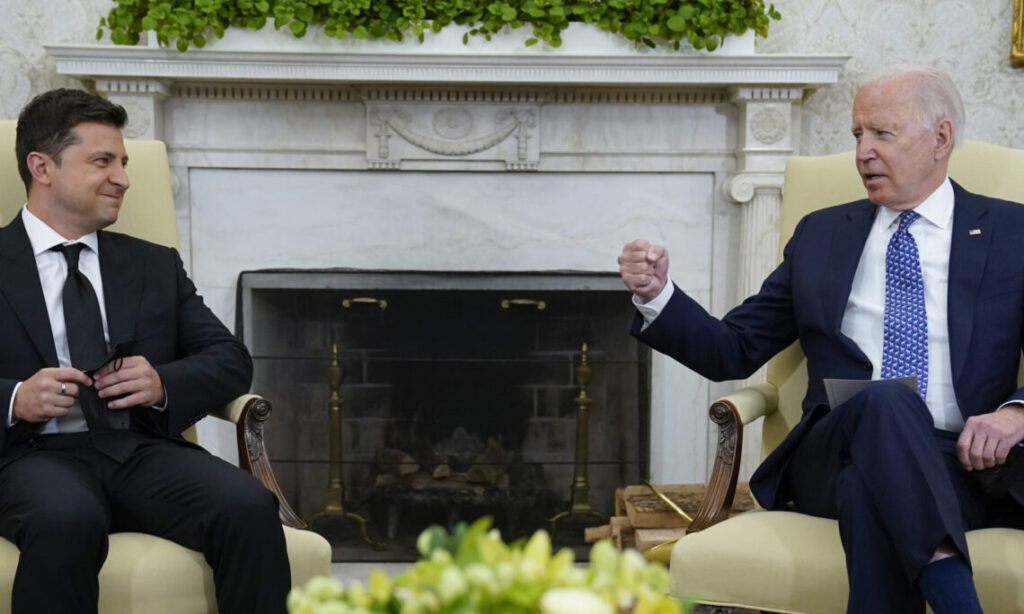The Red cell project
The Red Cell was a small unit created by the CIA after 9/11 to ensure the analytic failure of missing the attacks would never be repeated. It produced short briefs intended to spur out-of-the-box thinking on flawed assumptions and misperceptions about the world, encouraging alternative policy thinking. At another pivotal time of increasing uncertainty, this project is intended as an open-source version, using a similar format to question outmoded mental maps and “strategic empathy” to discern the motives and constraints of other global actors, enhancing the possibility of more effective strategies.
The United States and its allies are currently debating the merits of applying the so-called “Israel model” to Ukraine. The idea is both promising and deceptively simple: provide Ukraine with some combination of arms sales, security commitments, and military training that would enable the country — in a similar way to Israel — to deter and defend against future Russian aggression without the full risks of NATO membership. Though Israel-like security guarantees would help policymakers to avoid the politically thorny questions of Ukraine’s NATO accession, they are not without risks. The US-Israel relationship shows that the more credible the U.S. commitment to Israel has become, the more that Israeli leaders have come to believe that Washington will always be there to bail them out. As a result, the relationship has become plagued by the challenges of entrapment. Over time, the United States has found it harder to achieve its own strategic goals, which increasingly diverge from those of Israel.
What Exactly is the “Israel Model”?
The Israel model was not an intentional policy choice. Over time, however, growing U.S. support for Israel ultimately evolved into a policy of security guarantees, strong political backing, and large arms transfers. U.S. support did not start with the creation of the state of Israel, as many assume. The United States did not start arming Israel until the 1960s, and it was not until the 1970s and 1980s that specific written security guarantees transformed that relationship into an informal strategic alliance. Those decisions resulted from realpolitik logic rather than moral or ideological imperatives, and the domestically powerful pro-Israel lobby often associated with the relationship did not emerge until later decades. Instead, the relationship was founded on Israel’s value as an ally in the Cold War. Closer ties with Israel served to achieve larger goals: containing Soviet power and influence in the Middle East and establishing a US-led regional order.
The Israel model evolved against this strategic backdrop and developed three defining features:
- Israel is not a formal treaty ally but a “quasi-ally” of the United States. The United States and Israel have never entered a treaty alliance with Article 5-style mutual defense obligations. But the close ties between the two countries have cemented into something more than a transactional relationship. As President John F. Kennedy told Israeli Foreign Minister Golda Meir in 1962, “The United States has a special relationship with Israel in the Middle East, really comparable only to that which it has with Britain over a wide range of world affairs.” U.S. and Israeli leaders have continuously reaffirmed the notion of an “unbreakable bond” between the two countries, citing “shared values, shared interests, and true friendship,” that other countries — friends and foes alike — have also acknowledged.
- Notwithstanding the lack of a formal treaty commitment, the United States has provided written security guarantees to Israel. In 1975, the two countries signed a Memorandum of Understanding in which Washington pledged a “long-standing U.S. commitment to the survival and security of Israel,” to include every U.S. “effort to be fully responsive, within the limits of its resources and Congressional authorization and appropriation, on an ongoing and long-term basis, to Israel’s military equipment and other defense requirements, to its energy requirements, and to its economic needs.” Four years later, coinciding with the Camp David Accords, the United States committed to providing Israel with “support it deems appropriate” in the event of violations to the peace.
An additional Memorandum of Understanding, signed in 1981, established the institutional machinery for closer US-Israel cooperation through the Joint-Political Military Planning Group, the Joint Security Assistance Planning Group, and the Joint Economic Development Group. Taken together, these agreements effectively extended security guarantees to Israel, stressing America’s long-term commitment to the country.
U.S. security guarantees to Israel are not binding, but as a practical matter, all of America’s treaty commitments are ambiguous. NATO’s Article 5, for instance, requires members to take “necessary” action to support an ally if it is attacked, but it does not place members under any legal obligation to fight directly. This distinction matters: though the Biden administration often refers to the U.S. commitment to Article 5 as an “ironclad commitment,” Article 5 does not make U.S. military involvement automatic. As a result, the credibility of U.S. security guarantees — both those given to Israel and NATO countries alike — comes down to deeds, not words. From the start, the U.S. security guarantees to Israel aimed to keep Washington at arm’s length, and thus avoid alienating Arab countries, while the U.S. commitment to NATO always presumed a direct U.S. combat role.
U.S. security guarantees to Israel are not binding, but as a practical matter, all of America’s treaty commitments are ambiguous.
- Costly actions, including providing Israel with both strong political backing and billions of dollars in military assistance, make U.S. security guarantees to Israel more credible. All security commitments carry a challenge: to credibly convey to adversaries that the United States will honor its security commitment, and that Washington is not bluffing. To solve this challenge with respect to Israel, the United States sends costly signals — that is, messages, gestures, and actions that are costly enough to suggest that the commitment is no bluff.
Specifically, Washington provides Israel with strong political backing, including naming Israel a “major non-NATO ally.” This designation not only confers important military and economic benefits, but it also serves, in the State Department’s words, as “a powerful symbol of the close relationship between the United States” and Israel. Most important, the very public nature makes it more costly for U.S. leaders to back down without paying a steep price in terms of America’s reputation as a reliable strategic partner. It might also prompt domestic political fallout.
In addition, the United States has provided some $158 billion in military assistance to Israel to date. In 2016, the two countries signed a ten-year Memorandum of Understanding, with the United States committing to provide Israel with $38 billion in military aid, plus $5 billion in missile defense funding. These arms transfers, especially their scale, signals that the United States has a strong interest in maintaining Israeli security. These mechanisms have effectively made U.S. security guarantees more credible.
Can it Work in Ukraine?
Arming a state rather than allying with it formally can be an effective way to promote defense and deterrence without running the risks of binding treaty commitments. But a deeper understanding of the transformation of the US-Israel relationship over the last half-century suggests that there are likely to be both pros and cons to applying the Israel model in Ukraine. If policymakers do pursue this path, history suggests pitfalls of which they should be aware.
The most obvious benefit of building an Israel-style relationship with Ukraine is that it is one of the most efficient ways to strengthen Ukrainian deterrence and enable that country to defend itself. Indeed, in some ways, the United States has already spent the last 18 months building such a relationship with Ukraine. In the case of Israel, the United States has committed to maintain the country’s “qualitative military edge” to compensate for a quantitative disadvantage. To offset this numerical superiority, Israel relies on advanced technologies, much of which it acquires through foreign military sales and aid from the United States. The ways in which the United States is currently supporting Ukraine — including providing top-of-the-line weapons — are remarkably similar. Though they will not single-handedly enable Ukraine to win a war, Western systems such as Stinger missiles or Leopard tanks have been essential in helping Ukraine to damage and repel larger and better-equipped Russian forces. Committing to maintain Ukraine’s qualitative edge over the longer-term would largely be a recognition and formalization of existing practice.
One critical difference between Ukraine and Israel bears discussing here. Israel possesses an independent nuclear deterrent. Unlike NATO membership, the Israel model would not extend nuclear guarantees to Ukraine. But this distinction could be less significant than it first appears. Nuclear weapons are the ultimate guarantor, but as Russia’s war in Ukraine has shown, such weapons are relatively useless in conventional warfare — except to deter another nuclear-armed state from using them. Israel, though outnumbered and frequently attacked by its neighbors, has never had to resort to nuclear force; instead, it has relied on conventional deterrence. Providing Ukraine with an Israel model-like guarantee from the United States does not require that guarantee to be nuclear, but merely credible and conventionally powerful.
The creation of an arms- and supply-oriented partnership with Ukraine — rather than one that involves formal security guarantees — would resolve a similar dilemma to the ones faced by U.S. policymakers regarding Israel policy in the 1960s and 1970s. It would provide a way to maintain the regional balance of power and bolster Ukrainian deterrence without risking the potential for entrapment in any future war. Policymakers in the 1960s were keen to maintain their freedom of maneuver on Israel policy; a formal alliance is far less malleable than an informal partnership built around arms transfers. There is evidence that Ukraine has been willing to undertake relatively risky operations against Russia, from the apparent involvement of Ukrainian-aligned forces in the destruction of Nord Stream to their backing of radical far-right Russian forces in an attack on Russian soil. The Israel model, applied to Ukraine, could provide an alternative to NATO membership, while maintaining greater flexibility for policymakers going forward.
An Israel-style partnership also benefits US policymakers by increasing their influence and leverage. At various points during the 1970s, 1980s, and 1990s, U.S. leaders were able to use the prospects of future arms shipments to pressure or restrain Israel on key issues. President Jimmy Carter, for example, later recounted that he was able to encourage Israel to withdraw from Lebanon during its 1978 invasion. Arms sales played a crucial role in U.S. leaders’ ability to conclude peace deals such as the Camp David Accords. Similar benefits would likely apply in the Ukrainian case; a country that is reliant on Western arms and training is one that does not have an incentive to ignore all Western wishes, ensuring that US interests remain represented in the future.
An Israel-style model could also be used as a bargaining chip to encourage negotiations toward a potential cease-fire or end to the war. During the 1973 crisis, President Richard Nixon sought to use aid as a bargaining chip with the Israeli government to encourage the Israelis to move toward a peace deal. As one Pentagon official described it at the time, “the American hold on Israel is implicit in the whole diplomatic and aid situation.” Even without any undue leverage being used, a steady, confirmed flow of arms might encourage Ukraine to consider entering negotiations to end the war. At present, Ukraine has no guarantee that it will continue to receive arms if the war ends, creating a perverse incentive to continue fighting even at high cost. Including a commitment to future support for Ukraine in any peace deal would help to ameliorate this concern.
At the same time, there are downsides even to the kinds of relatively hands-off security relationship that the United States enjoys with Israel. For one thing, the Israeli case makes clear that this approach does not necessarily resolve underlying alliance management issues, nor does it prevent entrapment in future conflicts. Israel has often acted in ways that are counter to U.S. interests, particularly as the US-Israel relationship has become more politically popular and institutionalized. The Israel model thus carries many of the same dangers as more traditional forms of security guarantee in less acute form.
The United States has found its ability to constrain Israel on all but the most important matters of war and peace to be challenging. Consider, for example, the dismal U.S. record in preventing Israeli settlement activity in occupied areas of the West Bank. And there have been numerous times when Israeli officials have considered taking military action with the potential to draw the United States into a war, such as the 1981 Israeli strikes against an Iraqi nuclear reaction, or discussions over the last decade about potential strikes against Iran’s nascent nuclear program. In each case, despite the lack of a formal security guarantee to Israel, existing ties provided a strong political and social foundation in Washington that could ultimately have led to war.
Indeed, one of the key lessons of the Israel model is the potential for even a relatively informal arrangement to become bureaucratized and socialized over time. As the previous section explored, the US-Israel relationship was formed on the basis of largely realpolitik interests. Over time, however, consistent political and military-to-military interaction created a popular image of that relationship as based more in values and in shared democratic sentiment. Today, presidents face significant pressure from Congress, the Pentagon, and even defense contractors if they wish to impose leverage on Israel. Over time, policymakers might find that even informal security guarantees to Ukraine could become more constrained and less flexible.
More broadly, an Israel-style commitment to Ukraine might be no less threatening to Russia than a path toward NATO membership for Ukraine, not the least because any long-term security arrangement with Ukraine is liable to appear from the outside as a kind of “stealth path” to NATO membership for Ukraine, granting it de facto membership in the organization. Here again, though, an arms-focused security relationship with Ukraine might be the best of the available options.
Formalizing this relationship now — committing to an Israel-style security arrangement without peace talks — would eliminate Washington’s strongest bargaining chip with Kyiv to persuade it to compromise in peace negotiations.
A final concern pertains to timing. As discussed above, the Israel model could provide a viable way to enable Ukraine to defend itself in future, while incentivizing a cease-fire now. Yet if arms and funding are not effectively linked to a way to end the conflict, they could instead prolong it. In effect, the United States and its European allies have already begun to build an Israel-style relationship with Ukraine, with open promises of support for “as long as it takes.” Formalizing this relationship now — committing to an Israel-style security arrangement without peace talks — would eliminate Washington’s strongest bargaining chip with Kyiv to persuade it to compromise in peace negotiations. To avoid this pitfall, any future, more-permanent Israel-style approach to Ukraine must be tethered to a plan to end or freeze the conflict.
The Lesser of Two Evils
When compared with the pitfalls and risks of NATO membership for Ukraine — an outcome that in any case seems highly unlikely in the near-term — it is not difficult to see why the Biden administration and its allies have settled on the notion of an Israel model as Washington looks to enhance Ukraine’s future security. The US-Israel model offers a particularly promising way to enable Ukraine to defend itself while maintaining some flexibility for future U.S. policymakers.
At the same time, policymakers should be clear-eyed about the challenges ahead. The US-Israel relationship — created for realpolitik reasons — has undoubtedly served U.S. interests, but at other times it has impeded them. Over time, the increasing depth of the relationship has reduced the freedom of maneuver available to policymakers and created risks of entrapment and policy hijack more typical of a formal treaty alliance. But this alone is not a reason to cast aside the Israel model for Ukraine, much less default back to the NATO option. Instead, it is a warning to expect political headaches.
If policymakers elect to pursue an Israel model with Ukraine, they should start small and focus on clearly defined aims — such as bolstering Ukrainian defensive capabilities — rather than broader questions, such as alliance interoperability. Perhaps most important, U.S. policymakers should seek to tie any emerging form of security guarantees to moves toward a settlement in Ukraine — or risk losing their most effective point of leverage with Ukrainian leaders.




